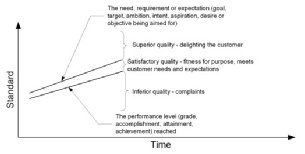© Transition Support Last edit 24/11/2023
Transition Support
A flexible approach to business improvement
Quality - what it means
The term quality is defined in ISO 9000 as the degree to which a set of inherent characteristics of an object fulfils requirements.
If we substitute the words underlined with the corresponding definitions in ISO 9000 we can deduce that quality is the degree to which a set of inherent distinguishing features of anything perceivable or conceivable fulfils a need or expectation that is stated, generally implied or obligatory. (Note inherent as opposed to "assigned", means existing in the object and therefore price is not a quality characteristic.
Needs, expectations, requirements and wants
We all have needs, requirements, wants, expectations and desires. Needs are essential for life, to maintain certain standards or essential for products and services to fulfil the purpose for which they have been acquired.
Requirements are what we request of others and may encompass our needs but often we don't fully realize what we need until after we have made our request. For example, now that we own a mobile phone we later discover we need hands free operation while driving and didn't think to ask at the time of purchase. Hence our requirements at the moment of sale may or may not express all our needs. Our requirements may include wants -
Expectations are implied needs or requirements. They have not been requested because we take them for granted -
Desires are our innermost feelings about ourselves and our surroundings, what we would like most.
In supplying products or services there are three fundamental parameters which determine their saleability or usability. They are price, quality and delivery. Customers require products and services of a given quality to be delivered by or be available by a given time and to be of a price which reflects value for money. These are the requirements of customers. An organization will survive only if it creates and retains satisfied customers and this will only be achieved if it offers for sale products or services which respond to customer needs, expectations, requirements and desires. Whilst price is a function of cost, profit margin and market forces and delivery is a function of the organization’s efficiency and effectiveness, quality is determined by the extent to which a product or service successfully meets the expectations, needs and requirements of the user during usage (not just at the point of sale).
Quality as a gap not as an absolute
The extent to which a product or service successfully meets the expectations etc is illustrated in the diagram below. Quality is an expression of the gap between the standard expected and the standard provided. When the two coincide (there is no gap) you have reached good or satisfactory quality, when there is a gap there is cause for dissatisfaction and opportunity for improvement.
The inherent characteristics of a product or service created to satisfy customer needs, expectations and requirements are quality characteristics. Physical and functional characteristics such as weight, shape, speed, capacity, reliability, portability, taste etc. Price and delivery are assigned characteristics and not inherent characteristics of a product or service and are both transient features whereas the impact of quality is sustained long after the attraction or the pain of price and delivery has subsided. Quality characteristics that are defined in a specification are quality requirements and hence any technical specification for a product or service that is intended to reflect customer expectations, needs and requirements is a quality requirement, Most people simply regard such requirements as product or service requirements and calling them 'quality' requirements introduces potential for misunderstanding.
Quality and safety
A quality product, service or process must be a safe product, service or process if it was designed to be safe. Thus safety is a quality characteristic, a distinguishing feature of a product, service, process or system. A product, service or process that meets quality requirements implies it meets safety requirement but meeting safety requirement does not necessarily mean it meets other requirements.
More information about quality and its meaning can be found in Chapter 6 of the ISO 9000 Quality Systems Handbook 7E and the Companion Website.
